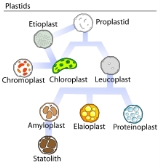
Etioplast
Overview
Chloroplast
Chloroplasts are organelles found in plant cells and other eukaryotic organisms that conduct photosynthesis. Chloroplasts capture light energy to conserve free energy in the form of ATP and reduce NADP to NADPH through a complex set of processes called photosynthesis.Chloroplasts are green...
s that have not been exposed to light. They are usually found in flowering plants (Angiosperms) grown in the dark. If a plant is kept out of light for several days, its normal chloroplasts will actually convert into etioplasts. Etioplasts lack active pigment and can technically be considered leucoplast
Leucoplast
Leucoplasts are a category of plastid and as such are organelles found in plant cells. They are non-pigmented, in contrast to other plastids such as the chloroplast....
s. High concentrations of etioplasts will cause leaves to appear yellow rather than green.
These plant organelle
Organelle
In cell biology, an organelle is a specialized subunit within a cell that has a specific function, and is usually separately enclosed within its own lipid bilayer....
s contain prolamellar bodies, which are membrane aggregations of semi-crystalline lattices of branched tubules that carry the precursor pigment for chlorophyll
Chlorophyll
Chlorophyll is a green pigment found in almost all plants, algae, and cyanobacteria. Its name is derived from the Greek words χλωρος, chloros and φύλλον, phyllon . Chlorophyll is an extremely important biomolecule, critical in photosynthesis, which allows plants to obtain energy from light...
.
Unanswered Questions

